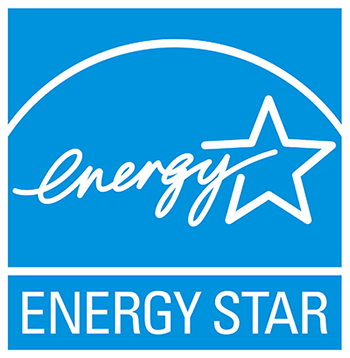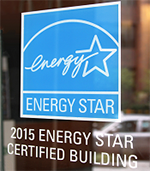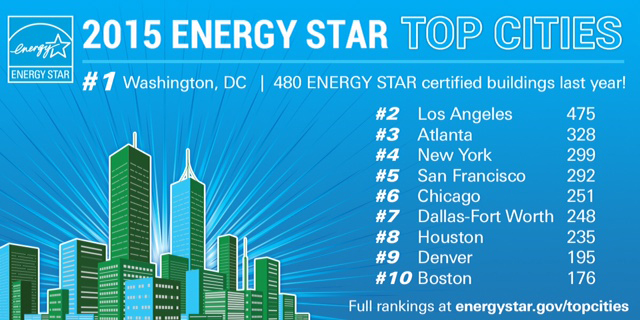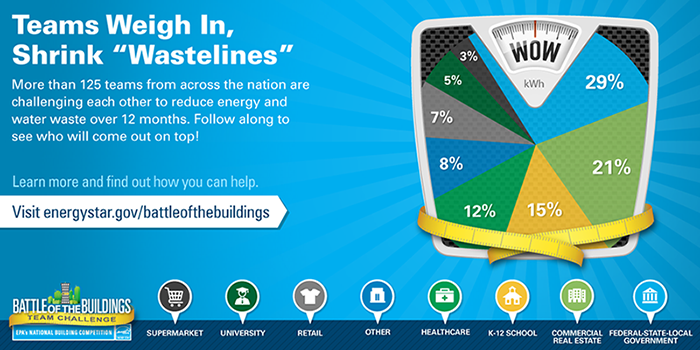
ENERGY STAR®
ENERGY STAR® is the simple choice for energy efficiency. For more than 20 years, EPA’s ENERGY STAR program has been America’s resource for saving energy, saving money and protecting the environment. Behind each blue label is a product, building, or home that is independently certified to use less energy and cause fewer of the emissions that contribute to climate change. Today, ENERGY STAR is the most widely recognized symbol for energy efficiency in the world, helping families and business save $360 billion on utility bills, while reducing greenhouse gas emissions by 2.5 billion metric tons since 1992.
Join the millions making a difference at www.energystar.gov.
What is ENERGY STAR?
ENERGY STAR is a U.S. Environmental Protection Agency voluntary program that helps businesses and individuals save money and protect our climate through superior energy efficiency.
Click here for a list of ENERGY STAR resources.
Upcoming Training Opportunities with ENERGY STAR®
Join us for some great learning opportunities.
To register for upcoming trainings, visit www.energystar.gov. If you won’t be able to attend, you can still view recorded trainings at this site (click “Recorded Webinars” under the Training drop-down menu on the left).
Ask The Expert
Wednesday, March 20, 2024 12:00 pm EDT
Wednesday, April 3, 2024 12:00 pm EDT
Wednesday, April 17, 2024 12:00 pm EDT
Wednesday, May 1, 2024 12:00 pm EDT
Wednesday, May 15, 2024 12:00 pm EDT
Wednesday, May 29, 2024 12:00 pm EDT
Every other Wednesday at noon, we’ll hold Portfolio Manager “Ask the Expert.” It’s a live webinar that gives all users an opportunity to ask their questions directly to EPA experts in an open forum. Want to talk to a “real” person? Have a question about how Portfolio Manager calculates your score? Want to learn more about entering Green Power? Join us, and we’ll answer all your questions about ENERGY STAR’s Portfolio Manager in this public forum.
Reducing Costs with Quick Water Wins
Wednesday, March 20, 2024 2:00 pm EDT
Reducing utility costs for your facility doesn't have to involve major retrofits or renovations. Significant water and cost savings can be achieved with small changes to operation and maintenance procedures and changes to user behavior. Learn about no- and low-cost solutions that can be implemented to start saving water in buildings right away, without the need for costly capital improvements.
Portfolio Manager 301: Spreadsheet Uploads, Setting Goals, and Creating Custom Reporting Templates
Tuesday, March 26, 2024 1:00 pm EDT
Thursday, April 25, 2024 1:00 pm EDT
Thursday, May 30, 2024 1:00 pm EDT
With a good background on the basic functionality of EPA’s ENERGY STAR Portfolio Manager tool, learn about some advanced features including: using spreadsheet upload templates to update property data; setting goals and targets to plan energy improvements for properties; creating custom reports; and using the Sustainable Buildings Checklist.
Financing Energy Efficiency Projects: What to Know Before you Sign
Tuesday, March 26, 2024 2:30 pm EDT
The webinar will review key factors managers should consider when comparing different financing options such as energy performance contracting and off-balance sheet financing. Bonds are mentioned, but not discussed.
Our presenter will also provide information on the Cash Flow Opportunity Calculator which helps inform strategic decisions about financing energy efficiency projects and calculates the cost of delay when postponing the installation. Using the tool, you will be able to estimate how much new equipment you can finance using anticipated savings, as well as whether you should finance now or wait for funding to be added to a future capital budget or a lower interest rate.
This financing session is specific to US funding opportunities and the information presented may not apply to other countries.
Portfolio Manager 101: Navigating Portfolio Manager, Adding a New Property and Entering Use Details, Analyzing Progress Using
Tuesday, April 2, 2024 1:00 pm EDT
Tuesday, May 7, 2024 1:00 pm EDT
Join us as we introduce and demonstrate the core functionality of EPA’s ENERGY STAR Portfolio Manager tool. Attendees will learn how to: navigate Portfolio Manager; add a property and enter details about it; enter energy and water consumption data; and generate template performance reports to assess progress.
Part 1: A Beginner’s Guide to Using Portfolio Manager for Benchmarking Law Compliance
Wednesday, April 10, 2024 2:00 pm EDT
Thursday, May 9, 2024 1:00 pm EDT
Are you a building owner who needs to comply with a mandatory benchmarking requirement? Do you have little or no experience using EPA’s Portfolio Manager tool?
You’ve come to the right place! This webinar will serve as a beginner’s guide to Portfolio Manager and provide you with all the essential “how-to” information you need to start benchmarking and reporting your building data to your local or state government. Topics covered will include understanding how state and local jurisdictions use EPA’s Portfolio Manager tool to facilitate reporting, setting up your Portfolio Manager account and properties, entering energy data, and reporting or sharing data with your jurisdiction.
Portfolio Manager 201: Editing Property Details, Data Quality Checker, and Sharing Property Data
Tuesday, April 11, 2024 1:00 pm EDT
Tuesday, May 21, 2024 1:00 pm EDT
Continue to learn about EPA’s ENERGY STAR Portfolio Manager tool, with a deeper dive into more advanced functionalities such as: editing property data; correcting and updating property use details; using the data quality checker; and sharing property data.
Achieving Water and Cost Savings in Capital Improvement Projects
Wednesday, April 17, 2024 2:00 pm EDT
Achieving significant water savings can often require going beyond the low-hanging fruit. Find out how to take the information collected during a facility water assessment to evaluate and prioritize larger-scale projects to maximizing water, energy, and cost savings. Get the information you need to include water efficiency in capital improvements through equipment retrofits and replacements during a renovation or when designing a new facility or space.
Portfolio Manager Upgrade
Tuesday, April 23, 2024 1:00 pm EDT
EPA is embarking on the largest upgrade to ENERGY STAR® Portfolio Manager® in a decade, including refreshing the user interface, enhancing current functionality, and adding brand-new features. In this webinar, the ENERGY STAR team will share the latest vision for potential changes and enhancements to Portfolio Manager that are planned for 2024 and beyond. There will be time for Q&A.
This upgrade is supported by funding from the Inflation Reduction Act of 2022 to advance the goal of reducing greenhouse gas emissions from commercial and residential buildings. You can follow along with the progress at www.energystar.gov/PortfolioManagerUpgrade.
Part 2: Using Benchmarking Results to Understand Your Building’s Performance
Wednesday, April 24, 2024 2:00 pm EDT
Wednesday, May 22, 2024 1:00 pm EDT
Are you a building owner who needs to comply with a mandatory benchmarking requirement? Do you have little or no experience using EPA’s Portfolio Manager tool?
You’ve come to the right place! This webinar will serve as a beginner’s guide to Portfolio Manager and provide you with all the essential “how-to” information you need to start benchmarking and reporting your building data to your local or state government. Topics covered will include understanding how state and local jurisdictions use EPA’s Portfolio Manager tool to facilitate reporting, setting up your Portfolio Manager account and properties, entering energy data, and reporting or sharing data with your jurisdiction.
How to Apply for ENERGY STAR Certification
Thursday, May 2, 2024 1:00 pm EDT
Join us to learn about applying for ENERGY STAR Certification in Portfolio Manager. Understand the value of the ENERGY STAR certification, see the step-by-step process of applying, and gain tips to help your property get from application to award.
Part 3: To Efficiency & Beyond! How to Benefit from Benchmarking Compliance with Strategies for Improving Energy
Wednesday, May 8, 2024 2:00 pm EDT
Thursday, June 6, 2024 1:00 pm EDT
Now that you’ve benchmarked and understand your results, it’s time to work on improving your buildings energy performance. In this session, you’ll learn about low-and-no-cost improvements that can help you reduce energy consumption and save money without significant capital investments. You’ll also learn about a variety of free ENERGY STAR resources that are available to help you improve your energy performance. Finally, you’ll learn how to connect with service provider organizations that can help you achieve your energy efficiency goals and earn ENERGY STAR certification for your building.
Verifying ENERGY STAR Certification
Thursday, May 16, 2024 1:00 pm EDT
Do you verify commercial building applications for ENERGY STAR certification? This webinar, based on the ENERGY STAR Guide for Licensed Professionals, covers the role of the licensed professional, as well as requirements for verifying commercial building applications for ENERGY STAR certification.
There’s a Return on Investment for an Energy Manager
Tuesday, July 9, 2024 3:00 pm EDT
Dedicated industrial energy managers at the corporate and site levels bring a lot of value to an energy program. In this webinar, an ENERGY STAR partner and ENERGY STAR Industrial Team member will discuss research on the value of an energy manager to a company, the most important qualities in an energy manager, the incentives available to companies hiring an energy manager, goals to establish for energy managers and how to persuade leadership to hire an energy manager.
US EPA ENERGY STAR Challenge for Industry

IMPROVING ENERGY EFFICIENCY 10% AT A TIME
The ENERGY STAR Challenge for Industry is a global
call-to-action for industrial sites to reduce their energy
intensity by 10 percent within 5 years. Any industrial site
can participate, and those that achieve this goal will earn
EPA recognition.
Learn more about eligibility, participation, and recognition.
Build Your Own Battle!

After several successful years hosting the ENERGY STAR National Building Competition: Battle of the Buildings, EPA is encouraging organizations like yours to build your own competition to save energy, water, or waste. Competitions can be a great way to motivate your team to find new efficiencies, engage occupants in your efforts, and multiply savings across your portfolio – all while helping the environment.
Why Build a Competition?
Competitions can help you:
- Save energy, water, and money – and reduce waste
- Identify best practices to leverage across your portfolio
- Jumpstart savings that last beyond the competition
- Work toward your sustainability goals
- Engage your occupants and local community
- Earn positive publicity for achievements
- Build momentum for benchmarking and improving efficiency
Anyone Can Build a Competition
Any organization, public or private, can build an efficiency competition, including trade associations, commercial businesses, manufacturing plants, utility companies, local and state governments, schools, congregations... and the list goes on! As long as you have more than one building in your portfolio or can recruit more than one building to participate, you can build a competition.
Ready to host your own competition? We have the tools you need!!
Celebrate ENERGY STAR Day on October 25!
 Help celebrate ENERGY STAR Day by taking the ENERGY STAR Pledge, a commitment to save energy and protect the environment from climate change, and get highlighted on our website for your support of the program and its goal of educating consumers about preventing climate change. Use these free communications resources to help you promote your participation and encourage others to join. If you’re hosting energy efficiency-focused events in October – Energy Awareness Month – we also invite you to put your event on the ENERGY STARs Across America map and let us showcase your efforts through the month of October to the thousands of visitors to our website. Are you ready to change the world with ENERGY STAR?
Help celebrate ENERGY STAR Day by taking the ENERGY STAR Pledge, a commitment to save energy and protect the environment from climate change, and get highlighted on our website for your support of the program and its goal of educating consumers about preventing climate change. Use these free communications resources to help you promote your participation and encourage others to join. If you’re hosting energy efficiency-focused events in October – Energy Awareness Month – we also invite you to put your event on the ENERGY STARs Across America map and let us showcase your efforts through the month of October to the thousands of visitors to our website. Are you ready to change the world with ENERGY STAR?
EPA Administrator, Chicago Archbishop: “We have a moral obligation on climate change”
On Friday, July 24, 2015, U.S. Environmental Protection Agency (EPA) Administrator Gina McCarthy and Archbishop Blase J. Cupich of the Chicago Catholic Archdiocese met in Chicago to discuss climate change, the Pope’s recent environmental encyclical, and EPA’s pending Clean Power Plan. Administrator McCarthy and Archbishop Cupich also discussed the Archdiocese of Chicago’s partnership with ENERGY STAR® and efforts to improve sustainability and energy efficiency.
In an article published in the Chicago Sun-Times, McCarthy and Cupich wrote, “With this step, the Archdiocese of Chicago became the first U.S. archdiocese to commit to benchmarking and tracking its energy, water, and emissions performance. We are already seeing the results in energy savings and carbon footprint impact as creation care is promoted in communities across Lake and Cook counties. The hope is that congregations across the nation will be encouraged to join this effort to promote environmentally important behavior by way of education and education through action.”
2015 ENERGY STAR Certification Applications Due November 16

Is your building among the most energy efficient in the nation? Consider applying for the ENERGY STAR! ENERGY STAR certified buildings use, on average, 35 percent less energy than similar buildings nationwide. So whether you’re interested in simply lowering your operating costs or establishing your organization as an environmental leader, you’ll find that there’s a lot of value in the ENERGY STAR.
This year you’ll have until November 16 to submit your application for 2015 certification.
Click here to learn the top Ten Reasons to Pursue ENERGY STAR Certification.
New Features in Portfolio Manager and Data Exchange Web Services Tools
EPA released new features to its ENERGY STAR Portfolio Manager® tool on August 3, including the ability for users to create reports that include more than two time periods. Checks of data quality have also been expanded to help users more easily identify and correct the underlying data issues that result in “Not Available” alerts within annual energy performance metrics. In addition, properties may be reassigned to different weather stations based on updates to the reference weather station dataset.
As part of this update, EPA also released enhancements to the Portfolio Manager data exchange web services tools. The highest impact updates include the ability for service providers that exchange data with Portfolio Manager to associate a single meter to a property, and a new capability to identify the reasons why a property is not receiving an ENERGY STAR score.
More information on the web services update is available here and additional information on the Portfolio Manager update is available here.
Texas and Ohio Compete to be Biggest Hospital Energy Loser
It all started with a friendly taunt. “What’s a buckeye, anyway?” asked Texas. Ohio’s response: “The nut is poisonous and was used...to stun or kill fish in still water.” The Texas Association for Healthcare Facilities Management and the Ohio Hospital Association put their game faces on and the first state-versus-state energy competition was born. More than 150 hospitals will be competing in 2015 to reduce the most energy as measured by EPA’s ENERGY STAR Portfolio Manager. Other state rivalries are rumored to be heating up! For information on how to start your own competition, see Battle of the Buildings. Visit www.tahfm.org for periodic updates on the OH/TX competition.
ENERGY STAR Partner Salt Lake City Recognizes Private Sector Air Quality Improvement & Energy Savings
On July 15, EPA’s Matthew Dalbey, Director of the Office of Sustainable Communities, joined Salt Lake City Mayor Ralph Becker and other city leaders to honor the winners of the Project Skyline Mayor’s Challenge 2015 Awards. Launched in May 2014, the multi-year competition challenges building owners across Salt Lake City to reduce citywide building energy use by 15 percent by 2020 and proactively meet—and exceed—the air quality and energy saving targets of the Mayor’s Sustainable Salt Lake – Plan 2015.
Participants in the Mayor’s Skyline Challenge are benchmarking in ENERGY STAR Portfolio Manager to evaluate their buildings’ energy use, set energy savings goals, and conduct energy saving improvement projects, putting the ENERGY STAR approach to strategic energy management into practice.
The Project Skyline Mayor’s Challenge is part of a broader effort to improve building efficiency in the city. In 2014, Salt Lake City was selected as a member of the City Energy Project, a national, 10-city initiative to cut energy waste in large buildings. In February of this year, the Mayor issued an Executive Order as part of the City’s Project Skyline directing department leaders to benchmark all city-owned facilities in Portfolio Manager, make benchmarking results transparent to the public, and develop annual energy management plans.
Learn more about Salt Lake City’s Project Skyline at www.slcgov.com/projectskyline.
Congratulations to Cenergistic, EPA’s ENERGY STAR Top Certifier
In July, EPA put out its first ever ENERGY STAR Top Certifiers list, which recognized 13 companies that each certified more than 150 facilities last year. At the top of the list was service and product provider (SPP) partner Cenergistic, which helped its customers achieve ENERGY STAR certification for a whopping 490 school buildings in 2014! You can see who else made the cut by checking out the full Top Certifiers list.
If you are interested in making improvements and achieving ENERGY STAR certification for your facilities, consider working with an ENERGY STAR SPP partner. An ENERGY STAR SPP partner can help you reduce energy costs and operating expenses and establish your organization as an environmental leader, while enhancing your employees’ productivity and job satisfaction. You can find a list of SPP partners here.
EPA also maintains a list of SPPs who have volunteered to verify applications for ENERGY STAR free of charge for K-12 schools and houses of worship.
For more information on how to achieve ENERGY STAR certification to highlight stellar management, please visit www.energystar.gov.
EPA Publishes the Annual 2014 ENERGY STAR Snapshot
The ENERGY STAR Snapshot is an annual report that provides an at-a-glance summary of the latest national ENERGY STAR metrics to help our partners see the impact of their efforts. Specifically, the Snapshot summarizes national, state, and local trends in energy and water benchmarking of commercial and industrial properties. It also provides information about ENERGY STAR certified commercial and industrial properties, and commercial building designs. Through 2014, more than 400,000 commercial buildings have been benchmarked in Portfolio Manager, and more than 25,000 buildings have been ENERGY STAR certified. Learn more about the benchmarked and certified buildings in your city and state by downloading this report.
Featured Certified Building: St. Anthony Hospital – Lakewood, Colorado

In June, St. Anthony Hospital in Lakewood, Colo., achieved its second consecutive ENERGY STAR certification. How did they do it? Key to the hospital’s success was the formation of an energy optimization team in 2012, comprised of St. Anthony’s facility operators and managers as well as professionals from design, commissioning, and controls and construction firms. In 2013, the team implemented a number of measures which will reduce their energy use by an estimated 8 percent and save $84,000 annually.
Energy savings measures implemented in 2013 include the following:
- Reprogrammed air flow in operating rooms to achieve variable flow – this reduces flow to the minimum flow required by code, but allows for air flow to increase quickly in response to surgery staff requests for cooler room temperatures. This measure saves fan, chilled water, and boiler energy when the extra air is no longer needed to cool the space; more than 80 percent of the occupied periods do not require extra air.
- Administrative area occupancy scheduling – space temperature and setpoints were programmed to achieve fan and plant energy reduction during unoccupied periods.
- Anesthetizing Area Humidity reduction – the hospital took advantage of an ASHRAE 170 change recently adopted by CMS that allows minimum humidity in anesthetizing areas to be reduced from 30 percent to 20 percent; this is a big energy saver in Colorado's dry climate
EPA’s 2014 ENERGY STAR Battle of the Buildings: Team Challenge
Did you know? The winner of EPA’s 2014 ENERGY STAR Battle of the Buildings: Team Challenge reduced energy use by 25 percent in just one year! Read their story and others in the 2014 wrap-up report.
EPA’s ENERGY STAR National Building Competition: Battle of the Buildings

For the sixth consecutive year, EPA’s ENERGY STAR program is hosting the National Building Competition: Battle of the Buildings to help school districts and organizations improve the energy and water efficiency of their buildings, save money, and protect the environment.
Improving energy efficiency in buildings is the single most effective way to eliminate energy waste. Energy use in commercial buildings accounts for nearly 20 percent of total U.S. greenhouse gas emissions and energy use at a cost of more than $190 billion per year. On average, 30 percent of the energy used in commercial buildings is wasted. Most of the energy used in the buildings where we work, play, and learn comes from the burning of fossil fuels at power plants, which contributes to climate change. The less energy we use, the fewer greenhouse gases we produce.
Be a Winner!
In the spirit of popular weight-loss competitions, participants from all 50 states and the District of Columbia are battling it out to see who can reduce their energy and water use the most. More than 125 teams and more than 6,500 individual competitors are measuring and tracking their building’s monthly energy and water consumption using ENERGY STAR® Portfolio Manager®, EPA’s online measurement and tracking tool. Many will work toward earning ENERGY STAR certification, the symbol of superior energy efficiency.
EPA will recognize the overall Top Teams and Top Buildings, determined by the percentage-based reduction in energy or water use achieved between 2014 and 2015. EPA will also recognize Top Buildings by building category using the same metrics, as well as all individual and team competitors who reduce energy or water use by 20 percent or more between 2014 and 2015.
Previous competitions provided a valuable platform for organizations to test innovative approaches and technologies that can be expanded to entire building portfolios. Today, the results of previous competitions serve as a source of best practices, lessons learned, and public energy performance data that can help inform the commercial building market. Achievements of past competitors are summarized in wrap-up reports on the competition website.
EPA maintains a competition website featuring a list of competitors and their “weigh-in” results, as well as tips and links to EPA’s existing inventory of ENERGY STAR tools and resources.
ENERGY STAR® Brand Awareness Continues to Grow
Brand Recognition Increases
May 2015, Washington, DC – Results from the National Awareness of ENERGY STAR® for 2014 are now available. Analysis of the data from the fifteenth annual Consortium for Energy Efficiency (CEE) household survey shows the strength of the ENERGY STAR brand by measuring label recognition, understanding, and influence on purchasing decisions.

Consistent adherence to the brand tenets by EPA and DOE and long-term brand promotion by members of CEE and trade allies has paid off. In 2014, 89 percent of households recognized the ENERGY STAR label when it was shown to them. This constitutes an increase of 48 percent since CEE first conducted the survey in 2000.
“This year’s survey results show that the ENERGY STAR label continues to be strongly recognized and used by the majority of Americans,” observed Kira Ashby, Program Manager with Evaluation, Research and Behavior at CEE. “This research demonstrates the continued impact efficiency program administrators have in promoting the label, and CEE members are proud to support this report.”
View report highlights or download the whole report.
ENERGY STAR Energy Efficiency Student Toolkit for K-12 Schools
K-12 schools in the United States spend more than $8 billion every year on energy costs alone. In fact, the energy used to light classrooms and hallways, power computer labs, and heat and cool school buildings costs more than textbooks and technology combined, and more than teachers’ collective salaries. Yet as much as 30 percent of energy consumed in schools is wasted! Read the reports...
Washington, D.C., Emerges for the First Time as Top City with the Most ENERGY STAR Certified Buildings
Today, the U.S. Environmental Protection Agency (EPA) announced the 2015 list of top cities with the most ENERGY STAR certified buildings. For the first time since 2008, a city other than Los Angeles leads the rankings. Washington, D.C., debuted in the top spot with 480 ENERGY STAR certified buildings in 2014. These and other cities across America are seeing the important role that their buildings can play in reducing greenhouse gas emissions.
“This list shows how America’s cities are leading the nation in cutting carbon emissions and fighting climate change,” said Jean Lupinacci, chief of the ENERGY STAR Commercial & Industrial program. “By embracing energy efficiency as a simple and effective pathway to reach their sustainability goals, these cities are demonstrating the tangible benefits that result from simple, cost-effective reductions in energy use.”

In most cities, commercial buildings are the largest source of carbon emissions. Chicago, for example, estimates that the energy used by buildings accounts for 70 percent of the city’s carbon emissions. In New York City, that figure jumps to nearly 80 percent.
To date, more than 25,000 buildings across America have earned EPA’s ENERGY STAR. These buildings have saved more than $3.4 billion on utility bills and prevented greenhouse gas emissions equal to the annual electricity use from 2.4 million homes.
Energy use in commercial buildings accounts for 17 percent of U.S. greenhouse gas emissions at a cost of more than $100 billion per year. ENERGY STAR certified office buildings cost $0.50 cents less per square foot to operate than average office buildings, and use nearly two times less energy per square foot than average office buildings. Commercial buildings that earn EPA’s ENERGY STAR must perform in the top 25 percent of similar buildings nationwide and must be independently verified by a licensed professional engineer or a registered architect. ENERGY STAR certified buildings use an average of 35 percent less energy and are responsible for 35 percent less carbon dioxide emissions than typical buildings. Many types of commercial buildings can earn the ENERGY STAR, including office buildings, K-12 schools, hotels, and retail stores.
ENERGY STAR® is the simple choice for energy efficiency. For more than 20 years, people across America have looked to EPA’s ENERGY STAR program for guidance on how to save energy, save money, and protect the environment. Behind each blue label is a product, building, or home that is independently certified to use less energy and cause fewer of the emissions that contribute to climate change. Today, ENERGY STAR is the most widely recognized symbol for energy efficiency in the world, helping families and businesses save $300 billion on utility bills, while reducing greenhouse gas emissions by two billion metric tons since 1992. Join the millions who are already making a difference at energystar.gov.
More on the 2015 top cities: www.energystar.gov/topcities
More on ENERGY STAR certified buildings: www.energystar.gov/buildinglist
More on earning ENERGY STAR certification for commercial and industrial buildings
